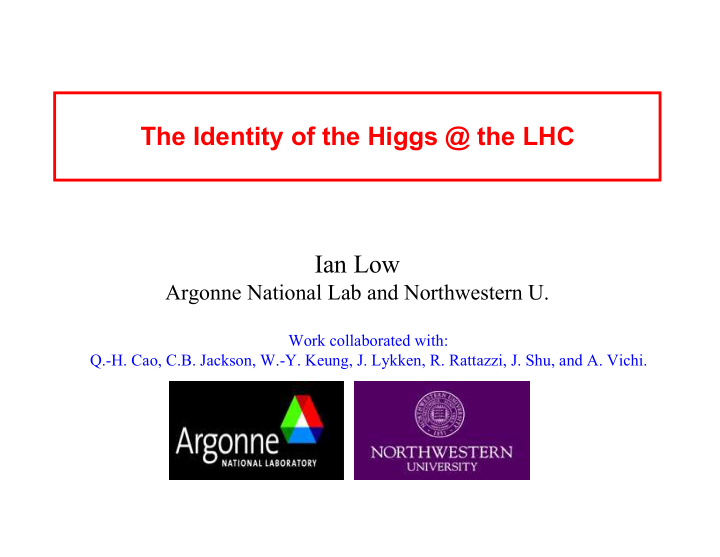



The Identity of the Higgs @ the LHC Ian Low Argonne National Lab and Northwestern U. Work collaborated with: Q.-H. Cao, C.B. Jackson, W.-Y. Keung, J. Lykken, R. Rattazzi, J. Shu, and A. Vichi.
What is the identity of the Higgs? UV Identity: • Is the Higgs fundamental or composite? • Is the new physics at the TeV scale, if any, follows from naturalness principle? IR Identity: • If we observe one or more scalars, how do we know it has a VEV that breaks the electroweak symmetry? • What’s its quantum numbers and electroweak properties? We need to answer them in order to navigate the infinite space of models!!
Some answers, by looking into : • Gluon-fusion production channel: Compositeness and naturalness (arXiv:0907.5413) • Decay into ZZ final states: Spin, CP, and origin of electroweak symmetry breaking (arXiv:0911.3398) • Ratios of decay branching fractions into pairs of electroweak vector bosons: electroweak quantum numbers (arXiv:1005.0872)
At the LHC gluon fusion is the dominant production channel of the Higgs! In the SM the dominant contribution comes from the top loop:
There are three ways new physics could modify the SM cross-section: 1. The Higgs-fermion-fermion coupling could be modified: (roughly) scale of new physics
There are three ways new physics could modify the SM cross-section: 2. The definition of the Higgs field may be modified:
Finally, there could a new loop diagram in addition to the SM top loop: 1. For non-supersymmetric theories, it could be a new top-like fermion, the top partner. 2. For supersymmetric theories, it could be a new top- like scalar, the stop.
When the new particle in the loop is heavy, the new contribution is encoded in the parameter c g :
Summarizing these three effects, we have Quite amazingly, the sign of three parameters all go in the direction of reducing the production rate for composite Higgs models. In addition, the interference between SM top and a heavy top-like fermion is destructive if the Higgs quadratic divergence is cancelled , and constructive if it is not cancelled .
Gluon Fusion Rate in the Universal Extra-Dimension (UED): The Higgs scalar is fundamental and its mass unnatural (fine- tuned). The rate is enhanced over the SM! F. Petriello, hep-ph/0204067
Gluon Fusion Rate in the littlest Higgs with T-parity (LHT): The Higgs is a composite scalar like the pion and the rate is reduced! Chuan-Ren Chen et al, hep-ph/0602211
• We found the gluon fusion production rate is a unique handle into the compositeness of the Higgs boson as well as the naturalness of the mass. • Composite Higgs models generally have a reduced gluon fusion rate. • Unnatural models tend to have an enhanced production rate. So this is an important number to measure precisely!
• Higgs -> ZZ ->4l is the gold-plated mode for the Higgs discovery when the mass is not too light. • There have been studies using the angular correlations to determine the spin and CP property of the resonance. I wish to emphasize the usefulness of two observables: the total width and φ , the azimuthal angle between the two decay planes of the Z.
A scalar decaying into ZZ • The Higgs mechanism predicts • But there are still two other possible couplings of a scalar with two Z bosons: Higgs mechanism predicts only this term!
• We computed the azimuthal angular distribution Negligible (~0.06) in the SM! • Previous studies only focus on c 1 but not c 2 !
We see the cos(2 φ ) dependence, signaling a spin-0 resonance. (Again cos( φ ) component is tiny! ) For spin-1 it should be cos( φ ).
Notice c 1 and c 2 will be difficult to tell unless the Higgs is heavy.
• Another handle makes use of the crucial observation that the two non- Higgs operators are both loop-induced:
• Thus in order to have a sizable branching ratio, the total width must be also loop-induced and order-of- magnitude smaller than that of the SM Higgs: Otherwise we simply would not observe the resonance in the ZZ channel due to the suppression in the branching ratio with around 30 fb of data!!
A non-Higgs like scalar would have a very narrow resonance, which is buried under the energy resolution of the detector!
• If a resonance is observed in the ZZ final states, the azimuthal angular distribution would provide crucial information on the spin and CP property of the resonance. • The width of the resonance provides a smoking-gun signal on the Higgs nature of the resonance ---- whether the scalar gives rise to masses to W/Z bosons through the Higgs mechanism!
Electroweak properties of a scalar resonance:
Recommend
More recommend